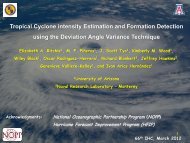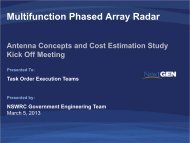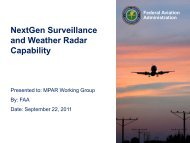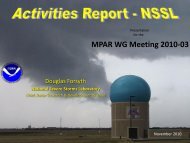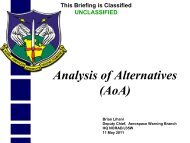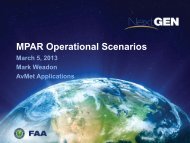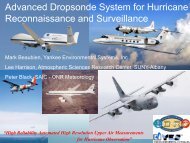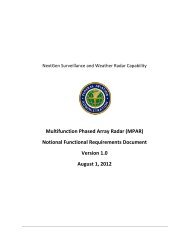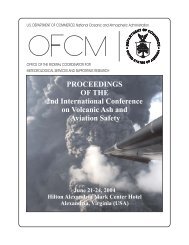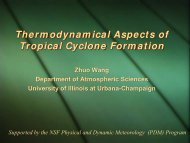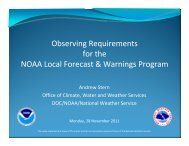General and Specific Characteristics for Model: HGSYSTEM
General and Specific Characteristics for Model: HGSYSTEM
General and Specific Characteristics for Model: HGSYSTEM
You also want an ePaper? Increase the reach of your titles
YUMPU automatically turns print PDFs into web optimized ePapers that Google loves.
<strong>General</strong> <strong>and</strong> <strong>Specific</strong> <strong>Characteristics</strong> <strong>for</strong> <strong>Model</strong>:<br />
<strong>HGSYSTEM</strong><br />
1 Abstract of <strong>Model</strong><br />
Capabilities<br />
2 Sponsor <strong>and</strong>/or<br />
Developing<br />
Organization<br />
<strong>General</strong> <strong>Characteristics</strong><br />
<strong>HGSYSTEM</strong> is a collection of computer programs designed to predict the source-term <strong>and</strong><br />
subsequent dispersion of accidental chemical releases with an emphasis on denser-than-air<br />
(dense gas) behavior. Multi-component releases may be modeled as well as chemicals that<br />
exhibit non-ideal behavior. Chemical reactivity may be modeled <strong>for</strong> hydrogen fluoride (HF) <strong>and</strong><br />
uranium hexafluoride (UF6) in <strong>HGSYSTEM</strong>-UF6. This version of <strong>HGSYSTEM</strong> includes all of the<br />
features <strong>and</strong> capabilities contained in <strong>HGSYSTEM</strong> 3.0 plus several code enhancements, including<br />
the addition of chemistry <strong>and</strong> thermodynamic modules simulating UF6 hydrolysis reaction<br />
influence on plume characteristics <strong>and</strong> dispersion. <strong>HGSYSTEM</strong> offers a broad spectrum of<br />
accidental release modeling capabilities.<br />
Sponsors:<br />
1.Shell Research, Industry Co-operative HF Mitigation/Assessment Program,<br />
Ambient Impact Technical Subcommittee [<strong>HGSYSTEM</strong> Version 1.0]<br />
2. American Petroleum Institute (API) [<strong>HGSYSTEM</strong> Version 3.0]<br />
3.U.S. DOE [<strong>HGSYSTEM</strong>-UF6]<br />
3 Last Custodian/<br />
Point of Contact<br />
Developers:<br />
Shell Research Limited [<strong>HGSYSTEM</strong>]<br />
Shell Research <strong>and</strong> Technology Centre<br />
Thornton, P.O. Box 1, Chester, CH1 3SH<br />
Earth Tech., Inc/ORNL- Lockheed Martin Energy Research Corp. [<strong>HGSYSTEM</strong>-UF6]<br />
Steven Hanna <strong>and</strong> Joseph Chang/San<strong>for</strong>d Bloom<br />
Contacts:<br />
Shell Research <strong>and</strong> Technology Centre ORNL, Doug Lombardi<br />
Thornton, P.O. Box 1 Bethel Valley Rd.,<br />
Chester, CH1 3SH Oak Ridge, TN 37831-6200<br />
Phone: 44 151 373 5851 [<strong>HGSYSTEM</strong>] (423) 576-9231 [<strong>HGSYSTEM</strong>-UF6]<br />
Fax: 44 151 373 5845 (423) 574-5788<br />
E-mail: hgsystem@msmail.trctho.simis.com<br />
4 Life-Cycle The first public domain release of <strong>HGSYSTEM</strong> version 1.0 was released in November of 1990<br />
followed by version 1.1 in 1991. Several later versions of the code were developed but not made<br />
publicly available. Version 3.0, released August 1995, is the second public domain version of<br />
<strong>HGSYSTEM</strong>.<br />
5 <strong>Model</strong> Description<br />
Summary<br />
Computer-based model to calculate the release properties of an accidental release of hydrogen<br />
fluoride (HF) including simulation of plume <strong>and</strong> jet behavior. Three areas where a great deal of<br />
uncertainty existed in previous models, which the code explicitly addresses, are: (1) the modeling<br />
of the complex thermodynamics of HF/H2O/air mixtures (including aerosol effects on cloud<br />
density), (2) the treatment of a wide range of surface roughness conditions, <strong>and</strong> (3) jet flow <strong>and</strong><br />
air entrainment <strong>for</strong> pressurized release of HF, followed by transition to ground-based dense gas<br />
dispersion.<br />
6 Application Limitation Some of the source-term models cannot be extended to highly stable meteorological conditions<br />
(e.g., no pool evaporation results can be obtained <strong>for</strong> a 1 m/s, F stability wind field). Furthermore,<br />
low momentum plumes, in general, are difficult to model when the initial plume velocity is small in<br />
magnitude. Overall, many of the computational models in <strong>HGSYSTEM</strong> are coupled to empirical<br />
correlations providing values <strong>for</strong> turbulence <strong>and</strong> dispersion parameters which are not robust <strong>for</strong> all<br />
meteorological conditions that may need consideration in a SAR analysis (i.e., low<br />
likelihood/worst-case meteorological conditions).<br />
A-141
<strong>General</strong> <strong>and</strong> <strong>Specific</strong> <strong>Characteristics</strong> <strong>for</strong> <strong>Model</strong>:<br />
<strong>HGSYSTEM</strong><br />
7 Strengths/<br />
Limitations<br />
7 Strengths/<br />
Limitations (Cont.)<br />
Strengths: <strong>HGSYSTEM</strong> offers the most rigorous treatments of HF source-term <strong>and</strong> dispersion<br />
analysis available <strong>for</strong> a public domain code. The code also offers modeling capabilities to other<br />
chemical species with complex thermodynamic behavior. Some special features in <strong>HGSYSTEM</strong><br />
include Aerosols <strong>and</strong> multi-component mixtures: Ability to model spillage of a liquid non-reactive<br />
compound from a pressurized vessel. Time-dependent dispersion: Ability to carry out more<br />
efficient simulations of time-dependent dispersion problems by automating the selection of output<br />
times <strong>and</strong> output steps in the HEGADAS-T model. Improve dosage calculations <strong>and</strong> time<br />
averaging (HEGADAS-T/HTPOST). Ability to model dispersion on terrain with varying surface<br />
roughness. Evaporating pools: Ability to include effects of dike containment (LPOOL). <strong>General</strong><br />
upgrade of evaporating pool model. User friendliness of <strong>HGSYSTEM</strong>: Upgrading of postprocessors<br />
HSPOST <strong>and</strong> HTPOST. Shared input parameter file. Sensitivity analyses per<strong>for</strong>med<br />
<strong>for</strong> LPOOL, SPILL, AEROPLUME, HEGADAS-S <strong>and</strong> HEGADAS-T to ensure robustness <strong>and</strong><br />
correctness of code <strong>and</strong> to evaluate effect of model parameters on dispersion analysis.<br />
Concentration predictions: Inclusion of a concentration profile in AEROPLUME that provides<br />
smooth transitions with the concentration profiles adopted in PGPLUME <strong>for</strong> airborne plumes. Reexamination<br />
of crosswind concentrations <strong>for</strong>mulation in HEGADAS. Improved aerosol model.<br />
Limitations: It is difficult to extend the physical/chemical data base utility DATAPROP to include<br />
additional chemical species. Such modifications would require an extremely good knowledge of<br />
the <strong>HGSYSTEM</strong> program structure <strong>and</strong> some consultation with the code developers. Releases<br />
from pipes cannot be calculated by <strong>HGSYSTEM</strong>. Liquid aerosol rainout is not modeled C all<br />
aerosol component is assumed to remain airborne until complete evaporation.<br />
8 <strong>Model</strong> References ! McFarlane, K., A. Prothero, J.S. Puttock, P.T. Roberts, H.W.M. Witlox, November 1990,<br />
“Development <strong>and</strong> Evaluation of Atmospheric Dispersion <strong>Model</strong>s <strong>for</strong> Ideal Gases <strong>and</strong> Hydrogen<br />
Fluoride — Part 1: Technical Reference Manual,” Report No. TNER.90.015, Shell Research<br />
Ltd., Thornton Research Centre, Thornton, Chester, CH1 3SH, Engl<strong>and</strong>.<br />
! L. Post (editor), 1994, <strong>HGSYSTEM</strong> 3.0 Technical Reference Manual, Report No. TNER.94.059,<br />
Shell Research Limited, Thornton Research Centre, P.O. Box 1, Chester, Engl<strong>and</strong>, Shell<br />
Internationale Research Maatschappij B.V.<br />
! L. Post, “<strong>HGSYSTEM</strong> 3.0 User Guide,” Report No. TNER.94.058, Shell Research Ltd.,<br />
Thornton Research Centre, Thornton, Chester, CH1 3SH, Engl<strong>and</strong>.<br />
A-142
<strong>General</strong> <strong>and</strong> <strong>Specific</strong> <strong>Characteristics</strong> <strong>for</strong> <strong>Model</strong>:<br />
<strong>HGSYSTEM</strong><br />
9 Input Data/Parameter<br />
Requirements<br />
Input is provided by means of the NAMELIST feature where a descriptive variable name is<br />
equivalent to a numeric value. Input file comment statements are also permitted to aid the<br />
description of input entries. In addition to the source-term model input requirements, detailed in<br />
the APAC Spills <strong>Model</strong> Review, the following AEROPLUME, LPOOL, PGPLUME, HFPLUME,<br />
HEGABOX, <strong>and</strong> HEGADAS inputs are used <strong>for</strong> subsequent dispersion analysis.<br />
AEROPLUME (Near Field Dispersion of High Momentum Jets)<br />
RESERVOIR Block — parameters describing the reservoir fluid thermodynamic state<br />
RELEASE Block — temperature of a stack release<br />
GASDATA Block — initial composition of the reservoir mixture <strong>and</strong> the relevant thermodynamic<br />
data including mole fraction of water, vapor specific heat at constant pressure, molecular weight<br />
natural convection heat transfer group, <strong>and</strong> species complete thermodynamic data<br />
PIPE Block — release pipe/orifice-plane conditions<br />
AMBIENT Block — conditions of the ambient environment<br />
DISP Block — parameters describing the dispersion characteristics (surface roughness <strong>and</strong> wind<br />
stability)<br />
MMESOPT Block — “switches” that indicate the use of the options <strong>for</strong> the modeling of wet/dry<br />
deposition, canyon effects, center-line concentration fluctuations, <strong>and</strong> plume lift-off)<br />
TERMINAT Block — sets reservoir release termination criteria<br />
MATCH Block — transition criteria <strong>for</strong> interface between AEROPLUME <strong>and</strong> on the far-field<br />
dispersion models<br />
LPOOL - single or multi-component (simulates boiling <strong>and</strong> time-dependent evaporation of a single<br />
or multi-component liquid pool on l<strong>and</strong> or water)<br />
GROUND Block — parameters used to describe the ground composition, temperature, <strong>and</strong> the<br />
dike composition <strong>and</strong> size (where applicable)<br />
SPILL Block — Spill type (user defined rate, Bernoulli, or choked flow), user-defined spills may<br />
consist of a sequence of up to 5 distinct spill rate <strong>and</strong> duration pairs.<br />
RESERVOIR Block — includes radius of a cylindrical tank, initial fluid level, equivalent diameter<br />
of reservoir orifice, <strong>and</strong> elevation of the orifice.<br />
LPOOL - multi-component (simulates the time-dependent evaporation of a multi-component liquid<br />
pool on l<strong>and</strong> or water).<br />
CONTROL Block — parameters <strong>for</strong> determining maximum simulation time, minimum film<br />
thickness of pool, <strong>and</strong> time step <strong>for</strong> pool data used to link to dispersion model<br />
GROUND Block<br />
AMBIENT Block — describes atmospheric conditions; includes relative air humidity, fraction of<br />
sky covered by clouds, spill starting time, <strong>and</strong> times <strong>for</strong> sunrise <strong>and</strong> sunset<br />
FLASH Block — user-specified flash <strong>and</strong> aerosol fractions; options of using <strong>HGSYSTEM</strong> to<br />
calculate the flashing fraction <strong>and</strong> aerosol generation or define the fractions of both.<br />
GASDATA Block<br />
MMESOPT Block — only contains 1 Y/N switch <strong>for</strong> the option associated with plume lift-off<br />
HEGABOX (Initial Spreading Phase of a Stagnant, Dense Cloud)<br />
CONTROL Block — specifies run control parameters (maximum simulated dispersion time,<br />
maximum time step, output printing control, <strong>and</strong> final termination Richardson number)<br />
SPILL Block — describes the spill of pollutant (spill size <strong>and</strong> initial cloud radius)<br />
AMBIENT Block — same as in AEROPLUME<br />
DISP Block — includes the option of specifying the Monin-Obukhov length rather than permit the<br />
code to compute the value<br />
GASDATA Block — same as in AEROPLUME with the natural convection heat transfer group<br />
replaced with: type of thermodynamic model, mole fraction of water adsorbed from earth’s<br />
surface, dilution by initial entrainment, thermal diffusivity of the dry pollutant, <strong>and</strong> kinematic<br />
viscosity<br />
A-143
<strong>General</strong> <strong>and</strong> <strong>Specific</strong> <strong>Characteristics</strong> <strong>for</strong> <strong>Model</strong>:<br />
<strong>HGSYSTEM</strong><br />
9 Input Data/Parameter<br />
Requirements<br />
(Cont.)<br />
MMESOPT Block — same as in AEROPLUME except no plume lift-off option available<br />
HEGADAS (Area Source Dense Gas Dispersion <strong>Model</strong>: Transient <strong>and</strong> Steady-State)<br />
CONTROL Block — specifies run control parameters (surface heat effects, concentration output,<br />
transient vs. steady-state simulation, cloud shape correction, convergence tolerance)<br />
AMBIENT Block — same as in AEROPLUME<br />
DISP Block — parameters describing the dispersion characteristics (surface roughness, wind<br />
stability, concentration, Monin-Obukhov length (optional), crosswind dispersion parameters,<br />
gravity spreading law constants, downwind dispersion coefficient <strong>for</strong>mula)<br />
GASDATA Block — same as in AEROPLUME with the addition of the following parameters: type<br />
of thermodynamics model, dry pollutant source emission rate, mole fraction of water adsorbed by<br />
pollutant, pollutant temperature, pollutant enthalpy, <strong>and</strong> liquid mass fraction in initial HF release<br />
CLOUD Block — controls the output of gas cloud in<strong>for</strong>mation<br />
CALC Block — specifies output time <strong>for</strong> which cloud concentration is calculated <strong>and</strong> printed<br />
AUTOTIM Block — specification of an “optimal” set of output times<br />
POOL Block — pool dimensions<br />
TIMEDATA Block — specifies the time-dependent source data either following release initiation or<br />
at a spatial breakpoint following post-jet/plume transition<br />
TRANSIT Block — specification of break point conditions<br />
MMESOPT Block — same as in AEROPLUME with the addition of an option <strong>for</strong> calculation of<br />
variation of concentration with averaging time<br />
10 Output Summary Each source-term module creates a number of different ASCII text output files including<br />
intermediate data values, time-dependent source-term results, <strong>and</strong> data files used by the<br />
dispersion analysis modules. A summary of the dispersion model output quantities follows:<br />
Dependent Variable (output)<br />
Independent Variable<br />
Centerline volume percent gas fraction<br />
Vertical dispersion coefficient<br />
Crosswind dispersion coefficient<br />
Half-width of middle part of crosswind concentration profile<br />
Temperature<br />
Effective cloud half-width<br />
Effective cloud height<br />
Cloud half-width (normal definition)<br />
Vapor concentration ( x, y, z)<br />
Vapor dose (x, y, z)<br />
x = downwind location, y = crosswind from plume centerline, z = vertical distance above grade<br />
11 Applications <strong>HGSYSTEM</strong> has been used in select cases to support Risk Management Plans (RMPs) <strong>for</strong> local<br />
emergency planning committees (LEPs) <strong>and</strong> analyses at the Gaseous Diffusion Plant Safety<br />
Analysis Report Upgrade Program.<br />
12 User-Friendliness Program is run in batch mode using a combination of customized batch files <strong>and</strong> input data files.<br />
Some manual manipulation of the data may be necessary when using utility programs such as<br />
DATAPROP results as input into a successive source-term model.<br />
13 Hardware-Software<br />
Interface Constraints/<br />
Requirements<br />
14 Operational<br />
Parameters<br />
a. Operating system: IBM PC compatible with a 80386 processor or greater, 4 Mbytes of RAM,<br />
<strong>and</strong> math coprocessor chip is optional but highly recommended<br />
b. Disk space required: 22 Mbytes hard disk space<br />
c. Run execution time <strong>for</strong> typical problem (CPU or Real Time): Several minutes (real time)<br />
maximum.<br />
d. Programming language: Microsoft FORTRAN Power station<br />
e. Interface with other codes: None<br />
f. Portability: Intended <strong>for</strong> compilation under Microsoft FORTRAN Power station <strong>and</strong> execution on<br />
a PC, but adaptable to any plat<strong>for</strong>m possessing a st<strong>and</strong>ard FORTRAN 77 compiler. DOS batch<br />
files are used to pipe input <strong>and</strong> output.<br />
Error Diagnostics<br />
Variety of diagnostic messages including input data file validation, runtime error messages,<br />
numeric convergence in<strong>for</strong>mation, warning messages, as well as run in<strong>for</strong>mation detailing the<br />
progress of the calculations.<br />
Batch Mode Capability (several cases at once)<br />
The individual program segments are executed at the DOS prompt by means of the desired<br />
program name followed by a list of input file(s) <strong>and</strong> an optional output file name. Although batch<br />
mode capability is not explicitly provided with the program, it would be a simple task to construct<br />
a DOS batch file that would execute the desired individual DOS comm<strong>and</strong> statements.<br />
A-144
<strong>General</strong> <strong>and</strong> <strong>Specific</strong> <strong>Characteristics</strong> <strong>for</strong> <strong>Model</strong>:<br />
<strong>HGSYSTEM</strong><br />
15 Surety Considerations Quality Assurance<br />
16 Runtime<br />
<strong>Characteristics</strong><br />
Part A: Source Term Submodel Type<br />
A1<br />
A2<br />
Source Term<br />
Algorithm?<br />
For Chemical<br />
Consequence<br />
Assessment<br />
<strong>Model</strong>s<br />
Part B: Dispersion Submodel Type<br />
It is unknown to what extent the source code has been verified. In some instances, modeling<br />
features documented in the user’s manual have been deactivated with no accompanying<br />
explanation in the source code or an accompanying “README” file. The source code has been<br />
made available since 1990 to permit verification of the way in which the models have been<br />
implemented.<br />
Benchmark Runs (comparison with other codes)<br />
<strong>HGSYSTEM</strong> has been benchmarked in comparison to 9 independent dense gas models:<br />
DEGADIS, SLAB, AIRTOX, CHARM, FOCUS, GASTAR, PHAST, TRACE, <strong>and</strong> the Britter &<br />
McQuaid model. Details are provided in Hanna, S.R., D.G. Strimaitis, <strong>and</strong> J.C. Chung, 1993,<br />
“Hazardous Gas <strong>Model</strong> Evaluation with Field Observations,” Atmospheric Environment, Vol. 27A,<br />
No. 15, pp. 2265-2285.<br />
Comparison with Field Experiments<br />
Comparison of code results to large scale field data has been per<strong>for</strong>med with the Burro, Coyote,<br />
Desert Tortoise, Goldfish, Han<strong>for</strong>d Kr85, Maplin S<strong>and</strong>s, Prairie Grass, <strong>and</strong> Thorney Isl<strong>and</strong> data<br />
sets. Details are provided in Hanna, S.R., D.G. Strimaitis, <strong>and</strong> J.C. Chung, 1993, “Hazardous<br />
Gas <strong>Model</strong> Evaluation with Field Observations,” Atmospheric Environment, Vol. 27A, No. 15, pp.<br />
2265-2285.<br />
Setup Time (first run, subsequent run)<br />
A first-time user may need between 2 <strong>and</strong> 1 day to completely set up a release analysis <strong>and</strong><br />
complete the source-term, dispersion, <strong>and</strong> post-processing analyses, assuming that all the<br />
necessary input data is readily available. Approximately 2 hours should represent the setup <strong>and</strong><br />
processing time <strong>for</strong> an experienced user. In the event that the analysis requires modeling of a<br />
chemical that is not included in the chemical database, several hours may be required to obtain<br />
all the necessary physical/chemical property data, depending upon the availability of data <strong>and</strong><br />
estimation methods <strong>and</strong> property correlations.<br />
U YES NO<br />
<strong>Specific</strong> <strong>Characteristics</strong><br />
Liquid spill: U pool evaporation particulate resuspension<br />
Pressurized releases: U two-phase jets U flashing U entrainment aerosol <strong>for</strong>mation<br />
Solid spills: resuspension sublimation<br />
B1 Gaussian U Straight-line plume Segmented plume Statistical plume U Statistical puff<br />
Part C: Transport Submodel Type<br />
C2 Deterministic Yes<br />
C4 Frame of Reference U Eulerian Lagrangian Hybrid Eulerian-<br />
Lagrangian<br />
Part D: Fire Submodel Type (Not Applicable)<br />
Part E: Energetic Events Submodel Type (Not Applicable)<br />
Part F: Health Consequence Submodel Type (No In<strong>for</strong>mation Provided.)<br />
Part G: Effects <strong>and</strong> Countermeasures Submodel Type (No In<strong>for</strong>mation Provided.)<br />
Part H: Physical Features of <strong>Model</strong><br />
H2 Release Elevation U ground roof<br />
H7 Cloud Buoyancy U neutral [passive] U dense [negative] plume rise [positive]<br />
A-145
<strong>General</strong> <strong>and</strong> <strong>Specific</strong> <strong>Characteristics</strong> <strong>for</strong> <strong>Model</strong>:<br />
<strong>HGSYSTEM</strong><br />
Part I: <strong>Model</strong> Input Requirements<br />
I1<br />
Radio(chemical)<br />
<strong>and</strong> Weapon<br />
Release<br />
Parameters<br />
Release rate: U Continuous U Time dependent U Instantaneous<br />
Release container characteristics: U vapor temperature U tank diameter<br />
U tank height U tank temperature U tank pressure U nozzle diameter<br />
U pipe length<br />
Jet release: U initial size U shape<br />
concentration profile at end of jet affected zone<br />
Release dimensions: U point line U area<br />
I2<br />
Meteorological<br />
Parameters<br />
Release elevation: U ground roof stack<br />
Wind speed <strong>and</strong> wind direction: U single point single tower/multiple point<br />
multiple towers<br />
Temperature: U single point single tower/multiple point<br />
multiple towers<br />
Dew point temperature: single point single tower/multiple point<br />
multiple towers<br />
Precipitation: single point single tower/multiple point<br />
multiple towers<br />
Turbulence typing parameters: temperature difference<br />
sigma theta<br />
sigma phi U Monin-Obukhov length roughness length<br />
cloud cover incoming solar radiation user-specified<br />
Four dimensional meteorological fields from prognostic model:<br />
Part J: <strong>Model</strong> Output Capabilities<br />
J1 Hazard Zone HEGADIS model has a post-processor that provides the calculation of the hazard zone.<br />
J3<br />
J4<br />
Concentration<br />
Versus Time Plots<br />
Tabular at Fixed<br />
Downwind<br />
Locations<br />
Part K: <strong>Model</strong> Usage Considerations (See Items 5 - 7.)<br />
Concentration values at select time intervals can be requested <strong>for</strong> output<br />
Virtually all output variables are presented in a tabular <strong>for</strong>mat<br />
A-146



